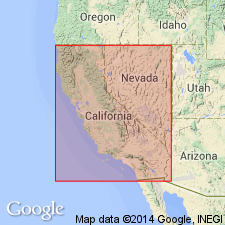
- Usage in publication:
-
- Beacon Peak Tuffs
- Beacon Peak rhyolite
- Beacon Peak gray upper tuff
- Beacon Peak pink lower tuff
- Modifications:
-
- Geochronologic dating
- Dominant lithology:
-
- Rhyolite
- Tuff
- AAPG geologic province:
-
- Sierra Nevada province
Summary:
Pg. 5 (table 1), 20 (table 2), 22, 37, 38, fig. 1, 2. Report on potassium-argon dating research pertinent to some problems of Cenozoic history of the Sierra Nevada. Rhyolite of Beacon Peak of Hudson (1951) and of Lindgren (1897) referred to as Beacon Peak Tuffs, Beacon Peak rhyolite (lower welded tuff and upper welded tuff), Beacon Peak gray upper tuff and Beacon Peak pink lower tuff. K-Ar ages on sanidine of upper welded tuff is 26.0 +/-0.5 Ma and of lower welded tuff is 33.2 +/-7 Ma. Age is considered to be late Oligocene or early Miocene.
Samples collected 1,500 ft N. 66 deg. W from SE/4 sec. 17, T. 17 N., R. 15 E., at 7,200 feet elevation, Beacon Peak, Donner Pass quadrangle, eastern CA.
Source: GNU records (USGS DDS-6; Menlo GNULEX); US geologic names lexicon (USGS Bull. 1350, p. 51).
For more information, please contact Nancy Stamm, Geologic Names Committee Secretary.
Asterisk (*) indicates published by U.S. Geological Survey authors.
"No current usage" (†) implies that a name has been abandoned or has fallen into disuse. Former usage and, if known, replacement name given in parentheses ( ).
Slash (/) indicates name conflicts with nomenclatural guidelines (CSN, 1933; ACSN, 1961, 1970; NACSN, 1983, 2005, 2021). May be explained within brackets ([ ]).

